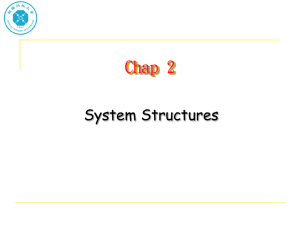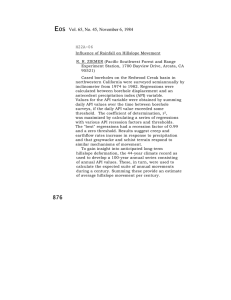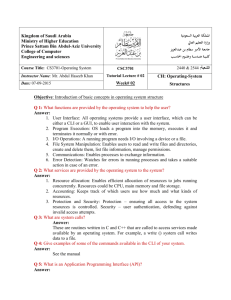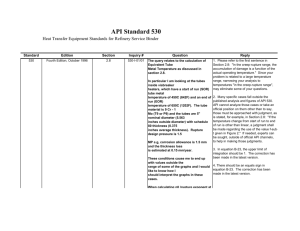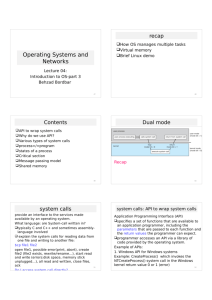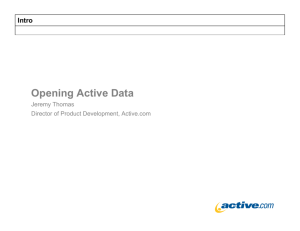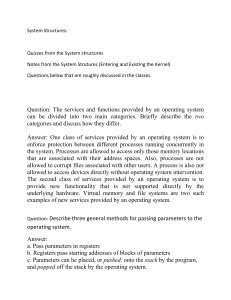• System Call • System Program • Linker/Loader with Examples
advertisement
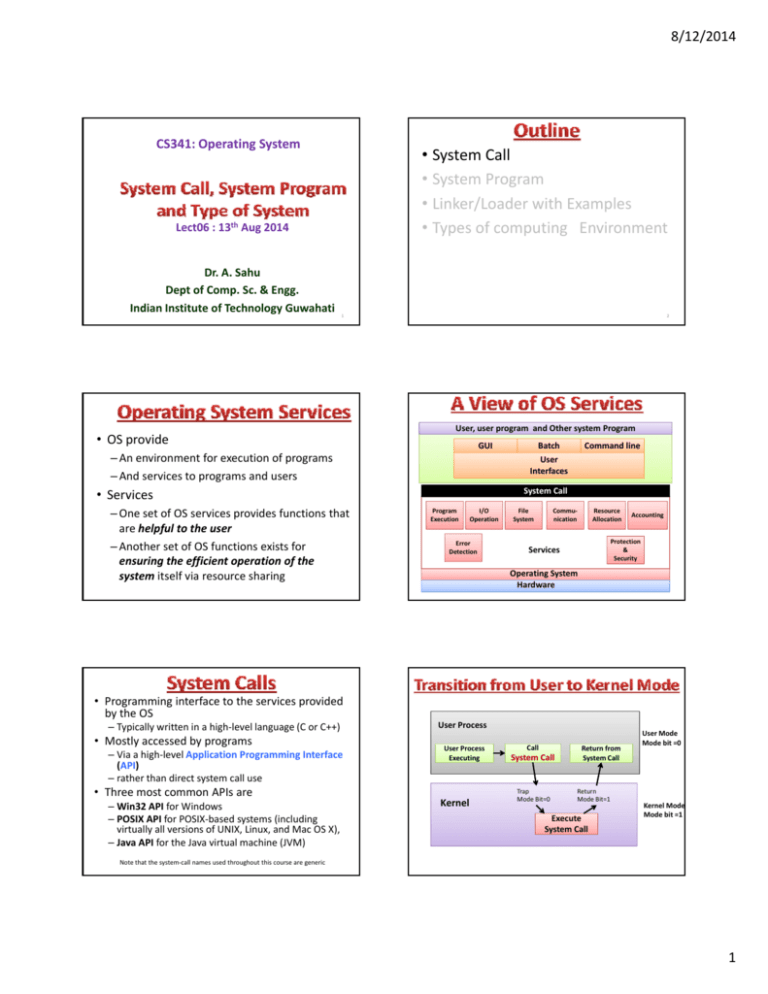
8/12/2014
CS341: Operating System
• System Call
• System Program
• Linker/Loader with Examples
• Types of computing Environment
Lect06 : 13th Aug 2014
Dr. A. Sahu
Dept of Comp. Sc. & Engg.
Indian Institute of Technology Guwahati
1
2
User, user program and Other system Program • OS provide GUI
– An environment for execution of programs – And services to programs and users
Command line
User
Interfaces
System Call
• Services
– One set of OS services provides functions that are helpful to the user
– Another set of OS functions exists for ensuring the efficient operation of the system itself via resource sharing
Batch
Program Execution I/O
Operation
Error Detection File
System
Commu‐
nication
Resource Allocation Accounting
Protection & Security
Services
Operating System Hardware
• Programming interface to the services provided by the OS
– Typically written in a high‐level language (C or C++)
• Mostly accessed by programs – Via a high‐level Application Programming Interface (API)
– rather than direct system call use
• Three most common APIs are – Win32 API for Windows – POSIX API for POSIX‐based systems (including virtually all versions of UNIX, Linux, and Mac OS X), – Java API for the Java virtual machine (JVM)
User Process
User Process
Executing Kernel Call System Call y
Trap
Mode Bit=0
Return from System Call Return Mode Bit=1
Execute System Call User Mode
Mode bit =0
Kernel Mode
Mode bit =1
Note that the system‐call names used throughout this course are generic
1
8/12/2014
C program invoking printf() library call, which calls write() system call
#include<stdio.h>
int main(){
printf(“Hello World”);
return 0;
return 0;
}
User Mode
Kernel Mode
System call sequence to copy the contents of one file to another file
Source
File
Example of Sys Call Sequence
Acquire input file name
Write prompt to screen Accept input
Acquire output filename
Write prompt to screen
Accept input
Open the input file
If file does not exist, abort Standard C Library (libc.so)
write()
write system call()
• Standard API to read data from file or I/O
#include <unistd.h>
ssize_t read(int fd, void *buff, size_t count);
• I/O device abstracted as File $ man 2 read // 2nd manual Destination
File
• Typically, a number associated with each system call – System‐call interface maintains a table indexed according to these numbers
• The system call interface – invokes the intended system call in OS kernel – And returns status of the system call and any return values
• The caller need know nothing about how the system call is implemented
– Just needs to obey API and understand what OS will do as a result call
– Most details of OS interface hidden from programmer by API • Managed by run‐time support library (set of functions built into libraries included with compiler)
Create output file
If file exist , abort Loop Read from input file
write to output file
Until read fails
Close output file
Write completion message to screen Terminate normally User Application open()
User mode
Kernel mode
System call Interface
System call Interface .
.
.
.
open(){
//Implemenation of open() system call ..
return }
2
8/12/2014
•
•
•
•
•
Process Memory Storage
I/Os Subsystem
Protection and Security
So user need system call service of OS for all above items 13
• A process is a program in execution
• Process is a unit of work within the system. Program is a passive entity, process is an active entity.
• Process needs resources to accomplish Process needs resources to accomplish
its task
–CPU, memory, I/O, files
–Initialization data
• Process termination requires reclaim of any reusable resources
14
• OS is responsible for the following activities in
connection with process management:
• Creating and deleting both user and system processes
• Suspending and resuming processes
• Providing mechanisms for –Process synchronization, communication, Deadlock handling
– Next Slide definition of synch., comm & deadlock
• Synchronization
– Two process trying access a shared object/variable . – Need to be access one at a time: Mutual Exclusion
– Mutex, Lock, Monitor ===> Pthread API
• Communication : When many process collaborate and do a big work, Sending message through d d bi
k S di
th
h
pipe/socket
• Deadlock
• Single‐threaded process –has one program counter specifying location of next instruction to execute –Process executes instructions sequentially, one at a time, until completion
– No progress – Circular Wait
17
3
8/12/2014
• Multi‐threaded process – has one program counter per thread
• Typically system has many processes, some user, some operating system running concurrently on one or more CPUs
concurrently on one or more CPUs
– Concurrency by multiplexing the CPUs among the processes / threads
create process, terminate process
end, abort, load, execute
get process attributes, set process attributes
wait for time, wait event, signal event
allocate and free memory
Dump memory if error
Debugger for determining bugs, single step execution
• Locks for managing access to shared data between processes
•
•
•
•
•
•
•
• To execute a program – All (or part) of the instructions must be in memory
– All (or part) of the data that is needed by th
the program must be in memory.
tb i
• Memory management determines what is in memory and when – Optimizing CPU utilization and computer response to users
21
• Memory management activities
– Keeping track of which parts of memory are currently being used and by whom
– Deciding which processes (or parts thereof) and data to move into and out of memory
dd t t
i t
d t f
– Allocating and deallocating memory space as needed
• Usually disks used to store data that – Does not fit in main memory – Or data that must be kept for a “long”
period of time
• P
Proper management is of central i f
l
importance
• Entire speed of computer operation really – Hinges on disk subsystem and its algorithms
4
8/12/2014
• OS activities
– Free‐space management, Storage allocation
– Disk scheduling
• Some storage need not be fast
– Tertiary storage includes optical storage, magnetic tape
– Still must be managed – by OS or applications
– Varies between WORM (write‐once, read‐
many‐times) and RW (read‐write)
• OS provides uniform, logical view of information storage
–Abstracts physical properties to logical storage unit ‐ file
– Each medium is controlled by device (i.e., disk drive, tape drive)
• Varying properties include access speed, capacity, data‐transfer rate, access method (sequential or random)
Hard Disk A
Main Memory A
Cache A
Register • Multitasking environments must be careful to use most recent value, no matter where it is stored in the storage hierarchy
• Multiprocessor environment must provide cache coherency in hardware such that all CPUs have the most recent value in their cache
• Distributed environment situation even more complex
– Several copies of a datum can exist
• Files usually organized into directories
• Access control on most systems to determine who can access what
• OS activities include
– Creating and deleting files and directories
– Primitives to manipulate files and directories
– Mapping files onto secondary storage
– Backup files onto stable (non‐volatile) storage media
• File System Management
• One purpose of OS is to hide peculiarities of hardware devices from the user
• I/O subsystem responsible for
– Memory management of I/O • Buffering (storing data temporarily while it is being Buffering (storing data temporarily while it is being
transferred), • Caching (storing parts of data in faster storage for performance), • Spooling (the overlapping of output of one job with input of other jobs)
– General device‐driver interface
– Drivers for specific hardware devices
• File management
– create file, delete file, open, close file
– read, write, reposition
– get and set file attributes
• Device management
– request device, release device
– read, write, reposition
– get device attributes, set device attributes
– logically attach or detach devices
5
8/12/2014
• Communications
– create, delete communication connection
– send, receive messages if message passing model to host name or process name: From
client to
client to server
– Shared‐memory model create and gain access to memory regions
– transfer status information
– attach and detach remote devices
• Systems generally first distinguish among users, to determine who can do what
– User identities (user IDs, security IDs) include name and associated number, one per user
– User ID then associated with all files, processes of that user to determine access processes of that user to determine access
control
– Group identifier (group ID) allows set of users to be defined and controls managed, then also associated with each process, file
– Privilege escalation allows user to change to effective ID with more rights Ex: sudo
Window
CreatePrtocess()
Exit Process()
WaitForSingleObject()
File
File CreateFile()
Manipulation ReadFile
WriteFile()
CloseHandle()
Device SetControlMode()
Manipulation ReadConsole()
WriteConsole()
Process
Control
Linux
fork()
exit()
wrait()
open()
read()
write()
close()
ioctl()
read()
write()
• Protection – any mechanism for controlling access of processes or users to resources defined by the OS
• Security – defense of the system against internal and external attacks
– Huge range, including denial‐of‐service, worms, viruses, identity theft, theft of service
– Privilege escalation allows user to change to effective ID with more rights
• Information maintenance
– get time or date, set time or date
– get system data, set system data
– get and set process, file, or device attributes
• Protection
– Control access to resources
– Get and set permissions
– Allow and deny user access
Window
Information GetCurrentProcessID()
Maintenance SetTimer()
Sleep()
Commu‐
CreatePipe()
nication
CreateFileMapping()
MapViewOfFile()
Protection
SetFileSecurity()
InitializeSecurityDescriptor()
SetSecurityDescriptor
Group()
Linux
getpid()
alarm()
sleep()
pipe();
shmget()
mmap()
chmod()
umask()
chown()
6
